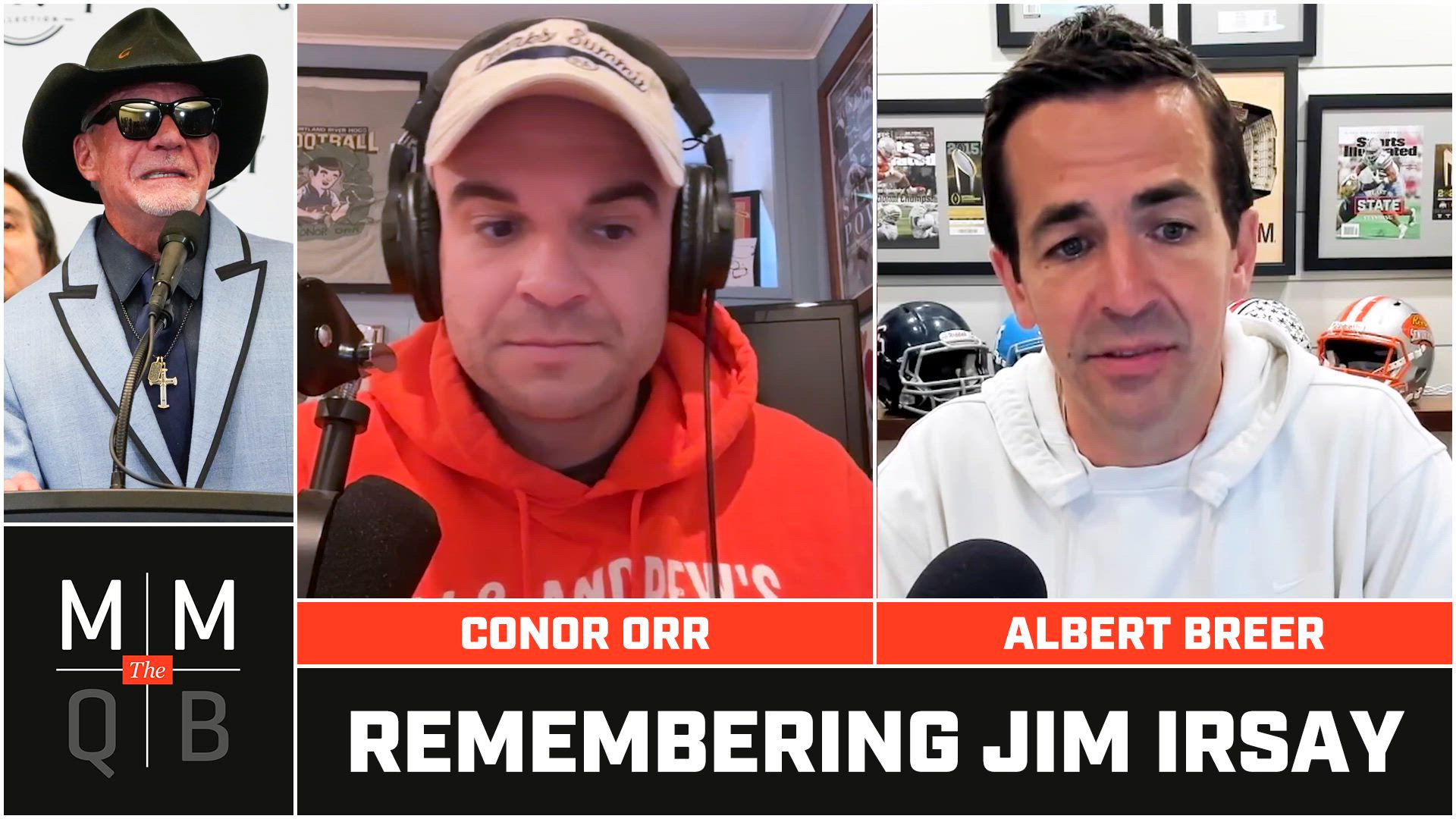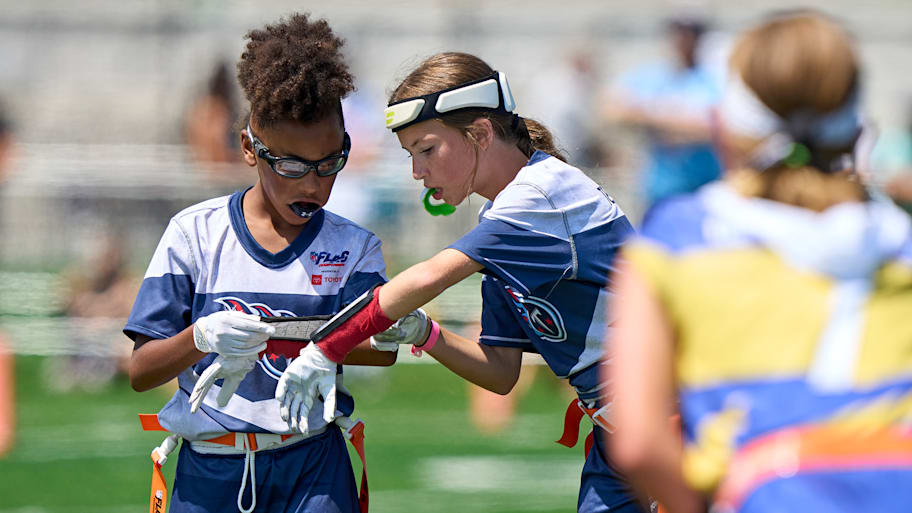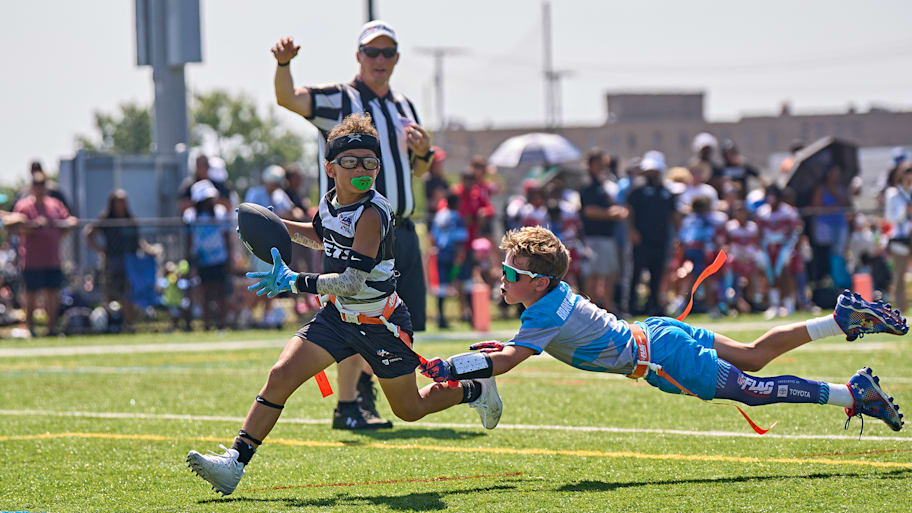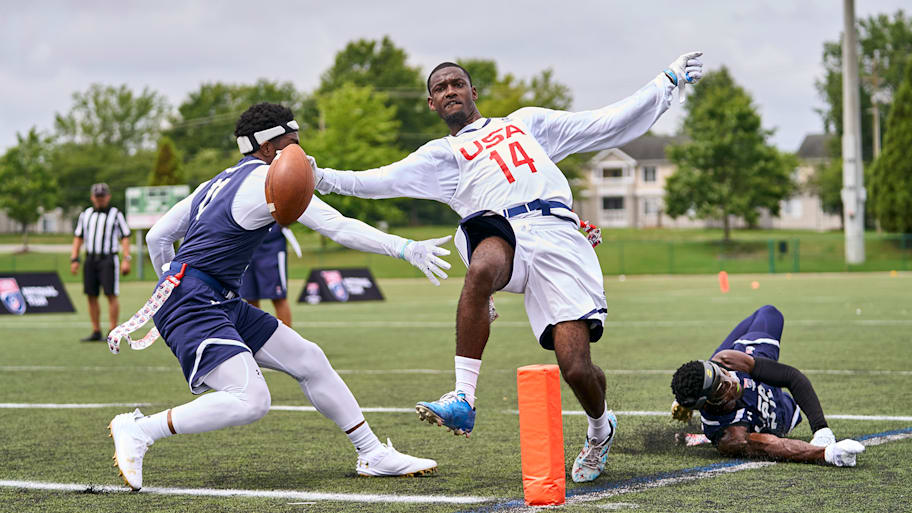
The International Federation of American Football quickly found a problem when it tried getting its sport into the Olympics about a decade ago. Forget any other reasons you might be skeptical about football catching on in the Games. Just look at the math: The participation field for each Summer Olympics is capped at 10,500 athletes, which means that without serious changes to the rest of the program, there would be no way to introduce traditional football and its 50-plus-man rosters. The conversations with the International Olympic Committee stalled.
“The numbers just didn’t work,” says USA Football president and CEO Scott Hallenbeck. “It’s that simple.”
The Olympics felt like a last cultural frontier. The U.S. has long aimed for global approval of the most American of sports. (The effort actually predates the modern professional game: The 1904 Games in St. Louis and the 1932 Games in Los Angeles included exhibitions with college players.) The NFL has poured resources into growing the sport abroad, especially over the last decade, with an increasing number of games overseas and marketing pushes to match. But even so, the general perception of football has remained distinctly, stubbornly American. The Olympics represented one last sphere of influence that football could not crack.
Or, at least, one it could not crack until those advocating for the sport changed their approach. They pivoted: What about 5-on-5 flag football? This would solve the problem of the numbers game, and, they realized, it was much easier to craft a strong pitch for flag than for tackle football. “It’s actually very competitive, more countries can play, it’s faster-growing, and it’s frankly more cost-effective,” Hallenbeck puts it.
The pitch worked. In October 2023 the IOC gave the green light to introduce flag football for both men and women at the 2028 Games in Los Angeles. NFL owners voted this week to allow their pros to participate. It will be the biggest platform the sport has ever seen. And it’s just one piece of a much larger ongoing effort to grow and redefine flag football.
The game is no longer the exclusive domain of grade school gym classes and college kids playing intramurals on the quad. For a growing population, simply put, flag football is football. There are more young children in the U.S. playing flag than playing tackle: In 2022, one million kids between ages 6 and 12 played flag, compared to 725,000 who played tackle, according to the Aspen Institute. The increase has been driven in large part by growth among girls: 15 states now sponsor flag as a girls’ high school varsity sport. More than a dozen others have introduced pilot programs.
Flag has a presence on the college level, too: It’s an NAIA women’s sport and there are plans to launch in select conferences in NCAA Division II and Division III. It’s caught on internationally more than has ever been the case for tackle football: There were 32 countries at the men’s and women’s flag football world championships in Finland in August. (The event had representation from six continents for the first time.) Even hardcore professionals now agree to wear a flag belt on occasion. The NFL Pro Bowl has been a 7-on-7 flag football game since 2023.
The game offers a very different vision of football—one that stakeholders increasingly agree is necessary to grow the sport. It’s noncontact, more open to female players, easier to spread internationally and far more accessible, which means it has an answer for nearly every major question about how to grow tackle football. All roads to the future of the game seem to be covered in flags.

“As the NFL thinks about reaching new audiences, what’s the way to do that?” says Stephanie Kwok, who worked in various jobs in tech and marketing after graduating from Harvard Business School in 2013. “When kids play a sport when they’re young, they’re more likely to become a fan as they grow up. And when you think about how we get more kids exposed to football, with flag you need a smaller field, fewer players, less equipment. It’s that much more accessible.”
She would know. In May, Kwok started a new job as the NFL’s first vice president, head of flag football.
The core question here might have sounded irrational not long ago for the NFL. The inescapable, inexorable cultural behemoth, grappling with a need for new fans? But the landscape of sports fandom has shifted.
Nearly all professional sports are facing existential questions about their relationships with younger generations. Kids today play and watch sports very differently than their parents did. There’s more early specialization in a single sport, less casual play overall, and, when it comes to viewership, the concept of appointment television has all but disappeared. The NFL may be larger, wealthier and more broadly popular than its peer leagues, but it’s not immune from these changes. And it faces a more fraught situation in terms of youth participation: Tackle football remains the most popular high school sport in the country for boys, yet amid growing concern about head injuries, the participation rate has fallen by 17% since 2006. The decline has leveled off in recent years but remains the largest decrease of any major sport.
But flag football has grown increasingly popular in the interim. That’s not only in response to safety concerns: It’s also cheaper, requires less equipment and is easier to play with smaller rosters. The number of children playing flag initially overtook the number of children playing tackle in 2017. There are some towns where youth tackle leagues disappeared because of a lack of interest and were replaced with flag. Even in regions where tackle is still thriving, flag has gained a foothold as an alternative to learn fundamentals in a safer environment before transitioning to tackle. It’s become far more prominent as an entry point to the sport.
And the sport has been a huge opportunity for growth among a previously untapped football demographic: girls.
“I think it’s this beautiful intersection where it’s the right thing to do, and it makes business sense to do,” says Kwok, who formerly played in multiple leagues and cofounded Pickup Football, which ran competitive flag tournaments for adults. “The growth of flag among females—what you’re seeing is there has been so much pent-up demand and interest for a long time that just hadn’t been met.”
The number of girls playing flag football grew 63% just from 2019 to ’23. That comes out to a total of some 500,000 girls. Many of them play under the aegis of the NFL: The league runs NFL Flag, the largest flag organization in the country, which has more than 1,800 youth leagues. Hundreds of those are for girls. The push to sanction flag as a girls’ high school varsity sport in various states—it’s official in California, New York and Florida among others—has also been boosted by the NFL. And with flag now established at an increasing number of colleges, there’s a pathway for girls to play after high school, too.
That investment has introduced the sport to countless new people. It’s been revolutionary for those who were already there.
“The shift has been huge,” says Liz Sowers, a former player who is now a coach. “I think the biggest thing is the NFL shining light on something that has been so traditionally a male sport.”
Sowers, 38, began playing on women’s tackle teams and embraced flag when she discovered that it presented a different challenge. She is now the head women’s flag football coach at Ottawa University in tiny Ottawa, Kan., where she has built a dynasty. Ottawa has won all five NAIA flag championships since the small-college organization introduced the sport in 2021. But when she took the job—she was among the first to be tasked with building a college flag football program—she had no idea how she was going to recruit. “Originally I was thinking, small town in Kansas, how am I going to get a bunch of young women to come move here to play flag football?” says Sowers.
There was no high school flag in the state at the time. She didn’t have scholarships to offer. But she found remarkably strong interest all the same. “I got a bunch of girls who were willing to just pack up and move within a month, a month and a half, and come to Kansas just for the pure love of the game,” she says.

The women who were freshmen in 2021 had started playing flag with little hope of being able to continue in college. (They had even less reason to imagine ever playing in the Olympics.) But the environment has changed so quickly that girls who are younger by just a few years have come up into a world of different opportunities. In the space of half a decade, an entirely new pathway has sprung up, with more opportunities to play from elementary school to adulthood.
Which, of course, has created an entirely new pool of people with personal connections to some form of football. There’s a similar dynamic at play with the growth of the sport internationally. “Flag is a really powerful way to grow the sport in other countries,” Kwok says. “It’s a more accessible way for people to experience football. If you’ve actually touched the ball, if you’ve caught a pass, if you have that experience, that’s just such a stronger connection to the game.” In other words? The NFL hopes it’s building a new pipeline of future NFL fans.
Much of the national attention devoted to flag football has focused on youth participation. But there’s a very different angle to consider for USA Football.
“We’re literally building a new elite sport,” Hallenbeck says. “We’re flying the plane while we’re building it.”
Here, too, people who have been here for years have been stunned by the recent investment. The national flag football teams have been in place for more than a decade, playing a fast, dynamic game that has become surprisingly competitive. (At the World Games in 2022, the U.S. men took gold after a close battle with Italy, 46–36, and the U.S. women lost to Mexico in the finals.) Some of the players have backgrounds in tackle football. But many came to flag as a distinct sport all its own. And those who come from tackle often realize they have to put aside much of what they believed about the sport.
That includes Eric Mayes, USA Football’s managing director of high performance and national teams. “I’ve had to deconstruct what I thought football was,” Mayes says. “I’ve had to learn to appreciate it and really just get engaged and invested in what flag football is, because it’s a different game. It’s a different discipline.”
Mayes played traditional football from kindergarten through college. He was an offensive lineman, a position which doesn’t exist in flag. “I think the gut reaction from someone like me hearing about flag football is, ‘Oh, that’s not, quote-unquote, real football,’” Mayes says. But he changed his mind when he started to watch high-level adult games. “It’s fast-paced, it’s exciting, it has the same scheme and back and forth between the coaches.” After a decade of working for the NCAA, he moved to USA Football in 2019, and he’s now in charge of building the tackle and flag national team programs.
That process is more complicated than it might seem. Part of it requires investing more in the current rosters, providing strength, conditioning and sports performance resources that had never been previously allocated to flag players. Part is looking outside the flag ecosystem to consider different athletes. That’s not just a matter of finding interested tackle players: While some positions translate, others require considerable adjustment, and so the national team has cast a broad net. Speed is essential. Receiver routes look more creative. The ability to break down opponents in open space is crucial. A defender who’s used to relying on physicality will have to change his game entirely.
All of which means athletes with experience in lacrosse or soccer or track just might adjust better than football players. As USA Football has scaled up its talent identification camps, 10% to 20% of the invites have consistently gone to athletes with a background outside football. (Cool Runnings for flag? “That’s right,” Mayes says.) And even tackle football players whose skills translate well have found a learning curve.
A receiver who’s used to relying on a stiff-arm to get away from defenders, for instance, will have to learn some new moves. “It’s all about movements with your hips, almost like you’re a dancer,” U.S. national team wide receiver Bruce Mapp says of flag protection, the equivalent of avoiding a traditional tackler. “I don’t want to say you’re like a ballerina or anything. But, you know, you’ve got to twist your hips.”
Mapp played at Coastal Carolina from 2012 to ’15, where he was all-conference twice, and he’s now in the school’s athletics Hall of Fame. If you had told him that he would end up playing flag, “I would have thought you were crazy,” he says. But when he discovered competitive flag tournaments after college, he realized the game could be far more intense than he realized. Soon he was hooked. Three years later, flag has taken him across the world and put him in highlights on SportsCenter. “My mentality had to shift,” Mapp says. “It’s an art.”
The switch Mapp made is one that several NFL players have expressed curiosity about. Playing flag, after all, would be their one chance at experiencing the Olympics. “I definitely want to,” Patrick Mahomes said last year. “But I’ve seen some of those guys play the flag football and they’re a little faster than I am. I know there’s not, like, linemen blocking for you.” USA Football has long said it would be happy to welcome them to the pool—“We’re very excited about the opportunity to engage them within our process," Mayes said last fall—and NFL owners made their eligibility official with a vote this week. It's a sign of how much the conversations around the sport have changed.
It’s almost unbelievable for someone like quarterback Vanita Krouch, a member of the women’s national team since 2016 who is accustomed to explaining that, yes, there really is a national flag football team and, no, it doesn’t look like what you played in gym class. Suddenly, everything is different. She was invited to the Pro Bowl last year as offensive coordinator under Team NFC head coach Eli Manning. (She says it was funny to see tackle players as fish temporarily out of water: She pointed out when they had their flag belts flipped inside out, and Manning’s initial plans were heavy on handoffs to running backs, even though flag is more passing-focused, “so we had to merge our two playbooks.”) Krouch has younger teammates who played in high school and had the opportunity to earn college scholarships. She has an eye on the Olympics. And she no longer has to explain quite so much about the game she loves.
“I feel like it’s almost like wildfire,” Krouch says. “The Olympics have opened up that door, that pipeline to say, ‘Hey, this is real, and we’re supported across the world.’ Everyone’s finding that this is a real sport. It’s real competitive.”
This article was originally published on www.si.com as Flag Football’s Olympic Moment Has Been a Long Time Coming.
